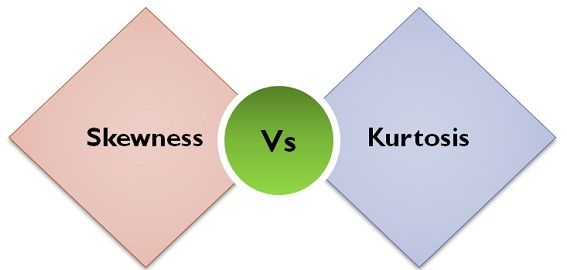 Skewness, in basic terms, implies off-centre, so does in statistics, it means lack of symmetry. With the help of skewness, one can identify the shape of the distribution of data. Kurtosis, on the other hand, refers to the pointedness of a peak in the distribution curve. The main difference between skewness and kurtosis is that the former talks of the degree of symmetry, whereas the latter talks of the degree of peakedness, in the frequency distribution.
Skewness, in basic terms, implies off-centre, so does in statistics, it means lack of symmetry. With the help of skewness, one can identify the shape of the distribution of data. Kurtosis, on the other hand, refers to the pointedness of a peak in the distribution curve. The main difference between skewness and kurtosis is that the former talks of the degree of symmetry, whereas the latter talks of the degree of peakedness, in the frequency distribution.
Data can be distributed in many ways, like spread out more on left or on the right or evenly spread. When the data is scattered uniformly at the central point, it called as Normal Distribution. It is perfectly symmetric, bell-shaped curve, i.e. both the sides are equal, and so it is not skewed. Here all the three mean, median and mode lie at one point.
Skewness and Kurtosis are the two important characteristics of distribution that are studied in descriptive statistics. To further comprehend the understanding of these two concepts, let’s take a look at the article given below.
Content: Skewness Vs Kurtosis
Comparison Chart
| Basis for Comparison | Skewness | Kurtosis |
|---|---|---|
| Meaning | Skewness alludes the tendency of a distribution that determines its symmetry about the mean. | Kurtosis means the measure of the respective sharpness of the curve, in the frequency distribution. |
| Measure for | Degree of lopsidedness in the distribution. | Degree of tailedness in the distribution. |
| What is it? | It is an indicator of lack of equivalence in the frequency distribution. | It is the measure of data, which is either peaked or flat in relation to the normal distribution. |
| Represents | Amount and direction of the skew. | How tall and sharp the central peak is? |
Definition of Skewness
The term ‘skewness’ is used to mean the absence of symmetry from the mean of the dataset. It is characteristic of the deviation from the mean, to be greater on one side than the other, i.e. attribute of the distribution having one tail heavier than the other. Skewness is used to indicate the shape of the distribution of data.
In a skewed distribution, the curve is extended to either left or right side. So, when the plot is extended towards the right side more, it denotes positive skewness, wherein mode < median < mean. On the other hand, when the plot is stretched more towards the left direction, then it is called as negative skewness and so, mean < median < mode.
Definition of Kurtosis
In statistics, kurtosis is defined as the parameter of relative sharpness of the peak of the probability distribution curve. It ascertains the way observations are clustered around the centre of the distribution. It is used to indicate the flatness or peakedness of the frequency distribution curve and measures the tails or outliers of the distribution.
Positive kurtosis represents that the distribution is more peaked than the normal distribution, whereas negative kurtosis shows that the distribution is less peaked than the normal distribution. There are three types of distributions:
- Leptokurtic: Sharply peaked with fat tails, and less variable.
- Mesokurtic: Medium peaked
- Platykurtic: Flattest peak and highly dispersed.
Key Differences Between Skewness and Kurtosis
The points presented to you explain the fundamental differences between skewness and kurtosis:
- The characteristic of a frequency distribution that ascertains its symmetry about the mean is called skewness. On the other hand, Kurtosis means the relative pointedness of the standard bell curve, defined by the frequency distribution.
- Skewness is a measure of the degree of lopsidedness in the frequency distribution. Conversely, kurtosis is a measure of degree of tailedness in the frequency distribution.
- Skewness is an indicator of lack of symmetry, i.e. both left and right sides of the curve are unequal, with respect to the central point. As against this, kurtosis is a measure of data, that is either peaked or flat, with respect to the probability distribution.
- Skewness shows how much and in which direction, the values deviate from the mean? In contrast, kurtosis explain how tall and sharp the central peak is?
Conclusion
For a normal distribution, the value of skewness and kurtosis statistic is zero. The crux of the distribution is that in skewness the plot of the probability distribution is stretched to either side. On the other hand, kurtosis identifies the way; values are grouped around the central point on the frequency distribution.






pritam karmakar says
It is too good source to get in statistics crucial points
Paavan Vishvas says
This is the best learning website I have ever seen……
Saratu David says
Really educative
Emmanuel says
Nice work
Sindisiwe Goodness Shongwe Dlamini says
Well explained relative points
Peter Westfall says
The interpretation of kurtosis is incorrect.
Ana Carol says
Great post!